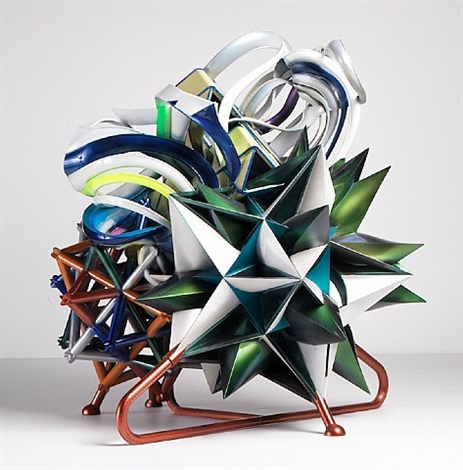The books are constructed of left over photocopies. The larger one uses Japanese papers as well, sandwiched between the printer paper. Their construction is detailed in a previous post.

I have since worked in to the books by repeating my process of tracing over and through, allowing the patterns to cover both sides of the pages. The first book detailed below is 9.7 x 11.4 cm, 15 fragmented pages and is constructed of fragments of colour photocopies of sketchbook pages.








I used a black ink pen to trace the patterns on to the blank sides of the paper. I traced all that I could see through the pages, using a light box and building the density. Text is also visible from repurposed paper. I find the messy overlap and overwhelm of the pages intriguing, it has elements of construction sites, road networks, commutes or flightpaths to it.Like the invisible threads that follow us through our daily timelines, criss-crossing as we pass each other by.
The next book is 13.2 x 13.2 cm, 14 pages and constructed of monotone photocopies that had been cut previously in to rough squares for a project that lost momentum. Some are missing corners and vary in shape as they were cut for the aesthetic value of the fragmentation of the pattern.








Some of the images had also been used to trace from, so the back side is covered in pencil graphite. I liked the contrast of the rough pencil filling spaces and building the lines thicker so I continued this is variation to complete all the pages. Only the pattern on the other side is transferred in this book form. Seeing the pages open in the photographs highlights some surprising compositions, the seem to provide movement while alluding to missing parts, like the parts of a story left to the imagination.
The large piece (23 x 30.5 cm, 17 pages including covers), is a blend of printouts and Japanese papers. The images are both digital versions of the patterns and digitally enhanced enlargements of drawn patterns.








This book is a combination of the previous two. The viewable patterns are traced on each page, using different materials/colour inks (black, grey ink, graphite, varying thicknesses) creating a density on a single page that is then enhanced by the underlying pages. There is a beauty in the unexpected symmetry that appears as the pages are turned.
I feel frustrated that I am trying to move away from constraint but seem to be moving further in to it.

 H: I love this so much, its starting to do something the white paper didn't do.I think the experiments with colour could also inform density/background.Try drawing with a thick ass Sharpie too. The thickest you can find. Just to see how that changes. 'Weight' on its own has so many possibilities, I'm so curious to see.With the stitches, I feel like I want there to be more density. I know you like the chain stitch, but I suggest going for something with more volume and relief like questions.Some of the drawings are dense in terms of weight & they are so beautiful. They overwhelm sometimes in an amazing way.I feel like that needs to come in with the stitches, I want to see thickness & more aggressive gestures.
H: I love this so much, its starting to do something the white paper didn't do.I think the experiments with colour could also inform density/background.Try drawing with a thick ass Sharpie too. The thickest you can find. Just to see how that changes. 'Weight' on its own has so many possibilities, I'm so curious to see.With the stitches, I feel like I want there to be more density. I know you like the chain stitch, but I suggest going for something with more volume and relief like questions.Some of the drawings are dense in terms of weight & they are so beautiful. They overwhelm sometimes in an amazing way.I feel like that needs to come in with the stitches, I want to see thickness & more aggressive gestures.  'The fold book' I would bind the papers but not make it a rigid book. The lines are crazy...what if you tried just binding things together in no order, as you write about order vs chaos. What if it doesn't conform to a book form?
'The fold book' I would bind the papers but not make it a rigid book. The lines are crazy...what if you tried just binding things together in no order, as you write about order vs chaos. What if it doesn't conform to a book form? The fragmented & reassembled pieces are starting to do that if you bind this way - try it!
The fragmented & reassembled pieces are starting to do that if you bind this way - try it! Keep layering until you can't layer anymore. Take the chaos to a crazy level... then bring it back.References for density from a simple material: John Chamberlain - the Foam Sculptures,
Keep layering until you can't layer anymore. Take the chaos to a crazy level... then bring it back.References for density from a simple material: John Chamberlain - the Foam Sculptures,



 Image 2: paper collage and acrylic in sketchbook, 21.5cm x 27cm
Image 2: paper collage and acrylic in sketchbook, 21.5cm x 27cm Regarding thoughts of the work, is to make the layers seem 'touchable' to bring the city and its hierarchal levels 'within reach' - sensual qualities of materials important to re-import the sensuality of data removed from quantitive research.
Regarding thoughts of the work, is to make the layers seem 'touchable' to bring the city and its hierarchal levels 'within reach' - sensual qualities of materials important to re-import the sensuality of data removed from quantitive research.